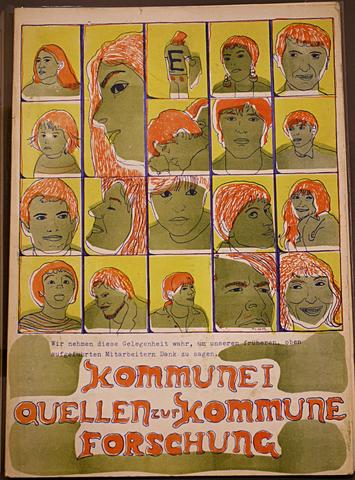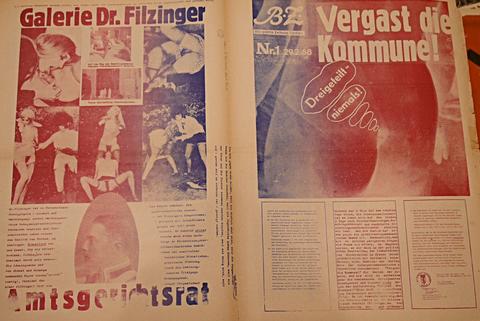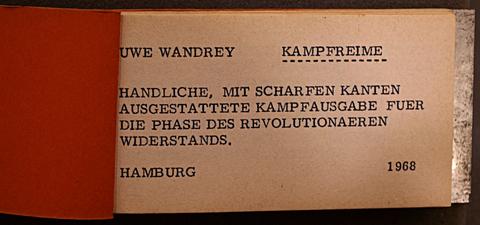Kommune 1: West Berlin
This selection of objects corresponds to the ideological approaches and activities of protest movements in West Berlin, and West Germany more broadly, as portrayed across various print media including pamphlets, fliers, underground newspapers, and publications, from 1957 through 1972. It traces the activities of different yet related groups: Gruppe SPUR, Kommune 1, and the Red Army Faction. Shifting from modes of détournement and other subversive aesthetic strategies, to challenging bourgeois middle-class values through text and image, to downright violent activities such as bombings, the trajectory of the German protest movements went from ‘protest’ to what Ulrike Meinhof defined as ‘resistance.’
Zeitschrift SPUR (1962) and Kommune I: Quellen zur kommune Forschung (1968) are compilations of the work and publications, including fliers and articles, produced by the two groups. While the SPUR publication traces the group’s development and collaboration with the Situationist International, the Kommune I source book provides a record of the commune’s development, while partially serving an instructional purpose. Dem Volk dienen: Rote Armee Fraktion: Stadtguerilla und Klassenkampf (1972) is a treatise produced by the RAF, propagating its ideas of armed struggle and presenting the darker, more violent factions emerging out of the 1960s student movements in West Berlin. This theme of violent resistance is foreshadowed in a still playful manner in Uwe Wandrey’s pocket-sized edition of Kampfreime (Combat Rhymes, 1968), a sharp-edged, combat edition book of humorous and poetic quotes to help further the revolutionary cause. Luchterhands Loseblatt Lyrik (1966) is a contemporary lyric poetry edition on loose sheets of paper, each poem featuring different typographies and imagery. Linkeck presents one of the many underground newspapers that circulated in West Germany during and after 1968. Other examples of countercultural press include Oberbaum Blatt, Charlie Kaputt, Agit 883, and Hundert Blumen, which deployed strategies of provocation through the use of explicit language and imagery to critique capitalist and colonial regimes and the authorities’ efforts at thwarting countercultural modes of resistance.
This catalogue published in Munich in 1962 compiles a number of artworks and documents produced by Gruppe SPUR as well some work done in collaboration with the Situationist International. It contains the first 6 issues of the journal SPUR, published by the group, 28 original black and white lithographs and 4 color lithographs created by the group and Asger Jorn and a number of manifestoes. In true Situationist fashion, it begins with the declaration that any of the images and texts may be partially or entirely detoured without permission.
This is a document published by Kommune I in May 1968, and as stated in the editorial statement, intended to provide a look back at the activities of the commune since its inception, through material published by and about them in the media.
This is the second issue of the underground Berlin newspaper Linkeck published by Bernhard Fleischer, Karin and Bernd Kramer, co-founders of the Karin Kramer Press and the bookseller Hartmut Sander, co-founder of the underground Oberbaumpresse, between 1968 and 1969. The editorial board consisted of members of the Linkeck commune in Berlin. The paper got much popularity due its first issue being officially confiscated on charges of obscenity, public offensiveness, advocating violence and infringement of trademark laws. This second issue was thus even more provocative and a response to the oppressive forces thwarting the first issue, deliberately targeting the officials involved in the legal case of the first issue.
Uwe Wandrey’s pocket-sized edition of Kampfreime (Combat Rhymes), published in Hamburg in 1968, is prefaced with the description “handy, sharp-edged combat edition for the revolutionary resistance phase.” [1] The small book is bound in sharp metal covers that exceed the boundaries of its stapled sheets, effectively transforming the book into a weapon capable of inflicting wounds and property damage. While violence is implied in the book’s form, the “Notwehrtauglich” (“suitable for self-defense”) sticker on its inner cover and the rhymes lend a humorous tone to the call for battle.
The treatise Dem Volk Dienen: Rote Armee Fraktion: Stadtguerilla und Klassenkampf (Serve the People: Red Army Faction: Urban Guerilla and Class Struggle) was published in April 1972, as one of the texts distributed by the Red Army Faction to provide an ideological justification for their violent actions.
The Luchterhand publisher launched their new poetry series Luchterhands Loseblatt Lyrik in 1966 under the direction of Günter Grass, Elisabeth Borchers, and Klaus Roehler, who would compile special editions of contemporary lyric poetry on loose sheets of unusually formatted paper, each poem or collection featuring distinctive typography and imagery.





